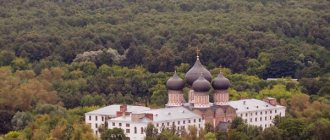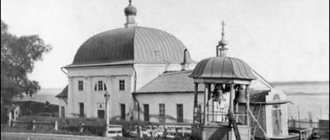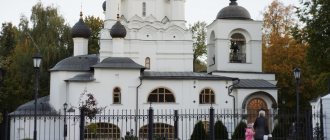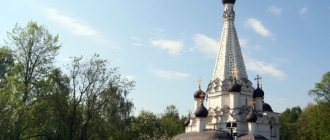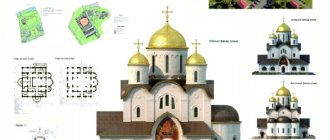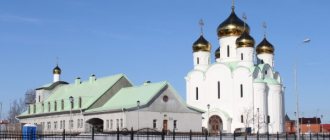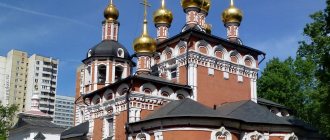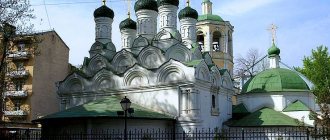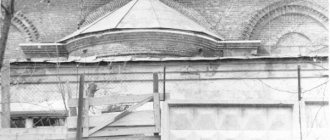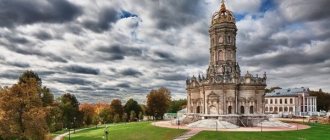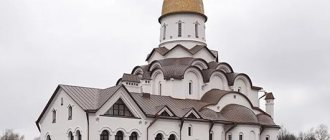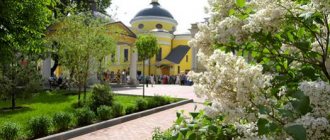The Church of the Intercession of the Blessed Virgin Mary, a unique temple architectural ensemble, is located in the South-West of Moscow, in Yasenevo, one of the most densely populated areas of the capital.
The majestic bulk of the Temple seemed to emerge from the depths of centuries in the midst of high-rise buildings and the noise of the metropolis, the Temple style of architecture of ancient Christianity was so organically reproduced. The magnificent interior decoration amazes with its exquisite luxury. The unique Christian shrines of the Temple give rise to a unique, reverent feeling of participation in the great mystery of Genesis.
Historical events
The Church of the Intercession of the Blessed Virgin Mary in Yasenevo, the construction of which began on September 21, 2008, was officially opened at the end of 2015.
Preparation for construction and construction of the Temple consisted of the following stages:
- 2001 - decision was made on the construction of the Temple-monument to Russian soldiers;
- 2002 – allocation of a site for construction;
- 2006 – approval of all necessary improvements to the project;
- 2007 – obtaining permission to build a temporary Temple;
- September 21, 2008 – Procession of the cross from the Temple of the Holy Apostles Peter and Paul, then a solemn prayer service dedicated to the beginning of construction;
- November 22, 2008 – ceremony of consecration of the temporary Temple (icon of the Mother of God “Quick to Hear”), installation of a memorial 6-meter cross;
- February 2009 – pouring of a monolithic reinforced concrete foundation;
- June 30, 2009 – ceremonial ceremony for the founding of the future Temple, then laying of a memorial stone.
The completion of construction was marked by the rite of the great consecration of the Intercession Church and the Divine Liturgy, performed on December 27, 2015 by Kirill, His Holiness the Patriarch of Moscow and All Rus', who was invited for this purpose.
The decision to erect the Temple as a monument to Russian soldiers was made in 2001 on the initiative of law enforcement and military departments, relatives and friends of military personnel who became victims of military conflicts, in which Russia has become a participant since the end of the 20th century. The Most Holy Theotokos, who covers the world with her honorable omophorion and eternally prays for peace, has always been especially revered by the Russian army.
For the first time, the appearance of the Most Holy Theotokos, spreading a fiery, lightning-like veil from her head over the inhabitants of Constantinople praying in the Blachernae Temple, is described in the Life of St. Andrew the Fool, in the Great Four Menaions. This phenomenon preceded the victory of Constantinople over the Muslim Saracens and the liberation of the city in 902 AD.
Russian Orthodox Church
On December 27, 2015, on the 30th Sunday after Pentecost, the holy forefather, His Holiness Patriarch Kirill of Moscow and All Rus' performed the rite of great consecration of the Church of the Intercession of the Most Holy Theotokos in Yasenevo, Moscow, and led the service of the Divine Liturgy in the newly consecrated church.
During the Liturgy, the consecration of Archimandrite Theodore (Casanova) as Bishop of Pereslavl and Uglich (Yaroslavl Metropolis) was performed.
Among those who greeted the Primate of the Russian Orthodox Church at the gates of the church before the start of the service was schoolgirl Mila Filimonova with her parents. Mila grew up in the St. Demetrius orphanage from infancy. On January 8, 2014, His Holiness Patriarch Kirill, during a visit to the children’s Christmas tree in the State Kremlin Palace, urged not to be afraid to adopt children and asked to adopt the girl Mila, who wrote him a letter. On September 3, 2014, while visiting the Pskov-Pechersky Monastery, His Holiness Patriarch Kirill met with Mila and her adoptive parents. Mila studies in the 4th grade of the capital's Dimitrievskaya comprehensive school and is raised in the family of Olga and Igor Filimonov, who are parishioners of the Church of the Intercession of the Holy Virgin in Yasenevo.
Concelebrating with His Holiness were: Metropolitan Barsanuphius of St. Petersburg and Ladoga, Administrator of the Affairs of the Moscow Patriarchate; Metropolitan of Yaroslavl and Rostov Panteleimon; Metropolitan Kirill of Yekaterinburg and Verkhoturye; Bishop Theophylact of Dmitrov, abbot of the St. Andrew's Stavropegic Monastery; Bishop of Rybinsk and Danilovsky Benjamin; Bishop Savva of the Resurrection, first deputy administrator of the affairs of the Moscow Patriarchate, abbot of the Novospassky stauropegic monastery; Schema-Archimandrite Iliy (Nozdrin); Archpriest Vladimir Divakov, Secretary of His Holiness the Patriarch for Moscow; Archimandrite Melchizedek (Artyukhin), rector of the Church of the Intercession of the Most Holy Theotokos in Yasenevo; Archpriest Andrei Milkin, head of the Patriarchal Protocol Service; Archpriest Anatoly Kozha, dean of the Paraskeva-Pyatnitsky district of Moscow, rector of the VMC church. Paraskeva Fridays in Kachalovo, in Butovo; Archpriest Nikolai Karasev, dean of the Andreevsky district of Moscow, rector of the Moscow Church of the Life-Giving Trinity in Starye Cheryomushki; Archpriest Alexander Peredernin, dean of the city of Pereslavl-Zalessky, Yaroslavl region; Archpriest Valerian Krechetov, rector of the Intercession Church in the village of Akulovo, Odintsovo district, Moscow region; Archpriest Vladimir Vigilyansky, rector of the Church of the Holy Martyr Tatiana at Moscow State University named after M.V. Lomonosov; clergy of the Moscow diocese and Yaroslavl metropolis.
Present in the church were the Chairman of the Synodal Department for Relations of the Church with Society and the Media V.R. Legoyda, deputy of the State Duma of the Federal Assembly of the Russian Federation, adviser to the Patriarch of Moscow and All Rus' Kirill on construction issues, member of the Board of Trustees of the Foundation for Support of the Construction of Moscow Cathedrals V.I. Resin, Chairman of the State Duma Committee of the Federal Assembly of the Russian Federation on Affairs of the Commonwealth of Independent States, Eurasian Integration and Relations with Compatriots L.E. Slutsky, Mayor of Pereslavl-Zalessky D.V. Koshurnikov, director of the art and production enterprise “Sofrino” E.A. Parkhaev, Chairman of the Board of the Charitable Foundation for Promoting the Construction and Reconstruction of Orthodox Churches in the Name of Archangel Michael P.I. Goncharov, builders and decorators of the Church of the Intercession of the Blessed Virgin Mary in Yasenevo, members of the delegation of the Yaroslavl Metropolis.
Liturgical hymns were performed by the choir of the Moscow Theological Academy under the direction of Hieromonk Nestor (Volkov) and the choir of the Church of the Intercession of the Most Holy Theotokos in Yasenevo (regent Daria Gavrus).
The service was broadcast live on the Soyuz TV channel. Numerous believers who did not make it into the crowded church watched the broadcast of the Patriarchal service on a large screen installed on the square in front of the church.
After the special litany, the Primate of the Russian Orthodox Church offered a prayer for peace in Ukraine.
During the Liturgy, His Holiness ordained Deacon Alexander Volkov, head of the press service of the Patriarch of Moscow and All Rus', clergyman of the Church of St. mts. Tatiana at Moscow State University named after M.V. Lomonosov.
The sermon before communion was delivered by priest Alexy Yakovlev, rector of the Moscow Church of St. Seraphim of Sarov in Raev.
In the altar of the newly consecrated Church of the Intercession, President of the International Film and Television Festival "Radonezh" E.K. Nikiforov presented His Holiness Patriarch Kirill with the highest award of the festival - the Silver Medal of St. Sergius of Radonezh - “for the 20-year feat of televangelism.” Since 1994, the program “The Word of the Shepherd” has been broadcast on Russian television, which was a real breakthrough in relations between the Church and the media. His Holiness Patriarch Kirill of Moscow and All Rus' (until 2009 - Metropolitan of Smolensk and Kaliningrad) became the first bishop of the Russian Orthodox Church to address viewers weekly from the screen of a federal television channel. In his response, His Holiness thanked E.K. Nikiforov and the festival jury for the award and called on church journalists to strengthen church unity.
At the end of the Liturgy, His Holiness Patriarch Kirill admonished Bishop Theodore of Pereslavl and Uglich to the service and presented him with the bishop’s staff. According to tradition, the newly ordained bishop gave the first archpastoral blessing to the believers.
The rector of the Church of the Intercession of the Most Holy Theotokos in Yasenevo, Archimandrite Melchizedek (Artyukhin), greeted His Holiness Patriarch Kirill and presented His Holiness with a mosaic image of the Intercession of the Most Holy Theotokos.
The Primate of the Russian Orthodox Church addressed the participants of the service with the Primate's word.
His Holiness donated the Nyametskaya Icon of the Mother of God to the community of the newly consecrated church.
In consideration of the work on the construction of the Church of the Intercession of the Most Holy Theotokos in Yasenevo, His Holiness Patriarch Kirill awarded Archimandrite Melchizedek with the Order of St. Sergius of Radonezh, III degree. The primate also congratulated Archimandrite Melchizedek on his name day and presented him with an anniversary cross made in memory of the 1000th anniversary of the repose of the holy Equal-to-the-Apostles Grand Duke Vladimir.
Also, in recognition of their assistance in the construction of the Church of the Intercession in Yasenevo, awards were given to:
- Chairman of the Board of the Charitable Foundation for Promoting the Construction and Reconstruction of Orthodox Churches in the Name of Archangel Michael P.I. Goncharov - Order of St. Seraphim of Sarov, III degree;
- General Director of Architectural Cabinet LLC V.I. Kozlov - Patriarchal Sign of the Temple Builder;
- General Director of PET - Promotion LLC V.E. Dementyev, General Director of SAM Trans-service LLC G.A. Krivozubova, General Director of StandardImmash LLC E.I. Zhilinskaya - anniversary medal in memory of the 1000th anniversary of the repose of the holy Equal-to-the-Apostles Grand Duke Vladimir.
A number of benefactors and benefactors of the temple were awarded Patriarchal diplomas.
His Holiness Patriarch Kirill prayed for everyone who helped in the construction of the Intercession temple complex in Yasenevo. A list of these people will be in a capsule, which will be placed in the wall of the temple as a sign of gratitude for their labors.
In conclusion, the Primate of the Russian Church again addressed the participants in the service: “I heartily congratulate all of you, my dears, on this festive Sunday, on a great event in the life of our city - the consecration of this magnificent church in Yasenevo. May the Cover of the Most Pure Queen of Heaven, in whose honor we consecrated this temple, extend over us. May the memory of all the victims of wars, of all the heroes who laid down their lives for the Fatherland, in whose honor this temple was erected, also be preserved in the pious hearts of Orthodox people.”
Then, on the territory of the Intercession Church in Yasenevo, a meeting took place between His Holiness Patriarch Kirill of Moscow and All Rus' with young parishioners - participants in the Orthodox youth organization “Intercession”. The volunteers told His Holiness about the main activities of the organization.
The Primate of the Russian Orthodox Church also visited and examined the lower church in the Pokrovsky temple complex in Yasenevo in honor of the Archangel of God Michael and other ethereal Heavenly Powers, in the interior of which the composition “Icon of the Holy Land” was created.
The Church of the Intercession of the Blessed Virgin Mary in Yasenevo (Litovsky Boulevard, 7A) is a unique temple-monument to all Russian soldiers who shed blood for the peace, freedom and tranquility of the Fatherland. Nine crosses with inscriptions mounted in the walls of the temple are dedicated to the memory of soldiers who gave their lives defending their homeland.
The central altar of the upper church is consecrated in honor of the Intercession of the Most Holy Theotokos. The walls of the upper temple are lined with mosaics. The lower church of the Intercession temple complex in Yasenevo was consecrated in honor of the Holy Archangel of God Michael and other ethereal Heavenly Powers. In the center of the lower temple there is a marble font. According to the creators, the lower temple is an “Icon of the Holy Land”. It recreates the place of the Nativity of Christ in Bethlehem, the Water Carrier from Cana of Galilee, the Prison of the Lord, the Edicule of the Holy Sepulcher, Golgotha, the Stone of Anointing, the Column of the Descent of the Holy Fire, the Chapel of the Dormition of the Blessed Virgin Mary.
Press service of the Patriarch of Moscow and All Rus'
Architecture, appearance
The Church of the Intercession of the Blessed Virgin Mary in Yasenevo is surrounded by a high stone fence. The area is small, very well-groomed and cozy, a real oasis in the middle of a noisy metropolis.
A small park, trimmed bright green lawns, paved paths between them, comfortable benches, 2 small fountains, two church shops (one sells candles and icons, the other sells delicious pastries) - everything pleases the eye and creates a calm, peaceful mood. The five-domed, four-footed Temple was built in the traditional Christian cross-dome style.
It was in this style that the very first Orthodox churches in Kyiv were built. The main dome crowning the church is typical for the temple architecture of Byzantium in the 11th-12th centuries; it is covered with gold, which means heavenly glory. Small blue domes with stars on them glorify the Mother of God.
The bells are installed in the two western chapters. The church has 3 porches (external porches), the main porch is located on the west side. The entire area of the Temple, including the vestibules, is 1425 m2. From the base to the domed cross, the height of the Intercession Church is 36 m.
The walls of the Temple in its lower part are decorated with white stone ornaments and carved crosses. The memorial crosses (there are 9 of them in total) were made by the best Vladimir craftsmen, who carved each cross according to the traditions of the era of the battle to which it was dedicated.
The construction of the Temple was carried out according to the design of the architect L.A. Petrova, in close collaboration with the Russian ethnographer, professor, Doctor of Historical Sciences V.I. Kozlov.
Video - Church of the Intercession of the Blessed Virgin Mary in Yasenevo
My stay at the Pokrovsky Temple in Yasenevo left a pleasant feeling. On the one hand, you understand that the temple is very young, and this can be seen from the technical details. On the other hand, looking at all this splendor, it seems that he emerged in the middle of a modern metropolis from the depths of centuries.
Majestic architecture, beautiful and meaningful design, unique Byzantine mosaics - all this makes the Intercession Church in Yasenevo particularly attractive. I was especially impressed by the exhibition of Christian shrines. What do you like most about this temple? I’m waiting for your opinion in the comments.
Interior decoration
The temple ensemble is built on 2 levels. At the top is the Church of the Intercession of the Most Pure Mother of God, the ground level is given over to the Church of the Archangel Michael, the leader of the army of the Lord and all the ethereal heavenly powers. The Lower Temple is also called “baptismal”; there is a marble font here, into which babies are lowered during the sacrament of Baptism.
Occupying the entire space, a unique project-exhibition “Icon of the Holy Land” is exhibited here, embodying the appearance of earthly Jerusalem.
The interior space of the Church of the Intercession of the Most Pure Virgin Mary, whose area is 1425 m2, forms a cross in projection. Above the main entrance inside the Temple, at a height of 8 m, there are choirs (an open gallery), where singers and musicians are usually located. The temple can accommodate up to 800 people at a time. The central space of the Temple is illuminated through windows in the main dome.
Inside, the walls are lined with Byzantine mosaics, covering more than 2.5 thousand m2. The mosaic, made according to the strict canons of Byzantine architecture, reflects the unity of the earthly world, Heaven and Paradise and personifies the appearance of Heavenly Jerusalem. Glowing, picturesquely inspired, light wall mosaic fascinates with its impeccable execution and warm color palette.
There seems to be a golden glow emanating from the walls. The floors are laid with magnificent mosaics of colored smalt, marble and black onyx and marble. According to the Bible, the banks along the rivers of paradise, the palace of King Solomon, and the Old Testament tent (tabernacle) were lined with onyx.
The mosaic covering the floor is made in the unique Cosmatesque style, named after the Roman marble maker Cosmati, who laid the foundation for unsurpassed mosaic architecture. In terms of the huge area of the mosaic, the uniqueness and beauty of the amazing internal design, the Intercession Church can compete with the best masterpieces of Byzantine temple architecture.
Shrines
The Church of the Intercession of the Blessed Virgin Mary, a parish of the Moscow city diocese created several years ago in the densely populated metropolitan area of Yasenevo (South-Western Administrative District), has unique shrines.
In the conch above the altar apse, the majestic figure of Christ Pantocrator, made in the form of a mosaic composition with an area of 45 m2, amazes the imagination. The Savior shining with gold from above vigilantly looks at those praying, listens to them and blesses them.
Church of the Intercession of the Blessed Virgin Mary in Yasenevo, figure of Christ.
In the stunning project “Icon of the Holy Land,” located in the basement Church of the Archangel Michael, copies of the most iconic objects of the Holy Land, the most sacred symbols of Christianity, preserving the memory of earthly life and the tragic atoning sacrifice of the Son of God were created.
Namely:
- marble Edicule (tiny chapel over the Holy Sepulcher);
- Stone of Confirmation (after being removed from the cross, His body was anointed with myrrh on this stone);
- the infamous Golgotha, where the Savior was crucified on the cross;
- Star of Bethlehem (14-pointed Silver Star, marking the place of the Nativity of the Savior);
- marble Tomb of the Blessed Virgin Mary.
They are made of real Jerusalem marble, absolutely identical in shape and size to the originals, consecrated with prayers and the sacred Holy Fire from the Edicule of the Holy Sepulcher.
In addition, the following are stored here:
- a copy of the stone water-bearing vessel in which the miraculous transformation of water into wine took place in Cana of Galilee, according to the will of Jesus;
- a copy of the dissected column of the convergence of the Holy Fire.
Here on the stand are exhibited the most valuable archaeological and historical artifacts from the Promised Land:
- an alabaster vessel (such vessels were used to store myrrh, a consecrated fragrant oil);
- particles of holy land from Jerusalem;
- a spear (this is how Longinus, a Roman soldier, pierced the heart of the crucified Jesus);
- a piece of silver (Judas betrayed Christ for 30 pieces of silver);
- mite (the poor widow put 2 such coins in a begging vessel in the Jerusalem Temple).
Each copy of the shrine is equipped with a tablet with a detailed description. These shrines provide an opportunity to touch with your heart the image of Jesus Christ and the Mother of God, to feel the real presence of God in your life.
Patronal holidays:
- Intercession of the Blessed Virgin Mary - October 14;
- Archangel Michael - November 21;
- Icon of the Mother of God “Quick to Hear” - November 22.
Interesting facts and legends
Main facts of interest to everyone visiting the Church of the Intercession of the Most Pure Theotokos for the first time:
- In 2001, a decision was made to build a Temple in memory of the fallen Russian soldiers. The development site was allocated in 2002. However, construction began only in 2008. Approval, organizational and preparatory work lasted for almost 6 years. Construction was completed in 2015.
- During the construction of the Temple, anyone could become the owner of a personalized brick, with a certificate attached; the owner’s name was also applied to the brick. Personalized bricks were laid into the walls of the future Temple, thus perpetuating the names of those who contributed to its construction. The names of the donors have been mentioned at every church service since then.
- This Temple is one of the youngest in Russia; its consecration took place in December 2015. But already in 2013, services began here.
- The temple was built in the ancient traditions of Russian temple architecture, which adopted the dome-cross shape from the famous Byzantine masters.
- Unique copies of the main five holiest Christian relics are kept here. They can be seen by everyone who does not have the opportunity to make a pilgrimage to the Holy Land, see them live and touch the shrines in Jerusalem.
- Even before the completion of construction, in 2014, the Temple received a diploma as the best among completed projects in the religious sphere.
- 12 bells were cast and raised to a height of 30 meters, the largest of which weighs 4.5 tons. The words of prayers are engraved in the upper part of the bells: “Praise God in His saints, to confirm His power,” “When you hear my voice, do not harden your hearts.” yours." The bells are decorated with images of our Lord Jesus Christ, the Mother of God and the most revered Orthodox saints.
- The main dome is covered with a layer of gold leaf, symbolizing the light of Divine Mercy.
- Festive services in the Church of the Intercession are held according to the type of the Jerusalem service, in recognition of the value of the architectural exhibition “Icon of the Holy Land” in the lower church of Michael the Archangel.
- The restoration within the walls of the Temple of famous Christian relics associated with the earthly hypostasis of the Savior and his mother the Mother of God was accomplished according to the plan and under the strict leadership of Archimandrite Melchizedek, the rector.
- Archimandrite Melchizedek received the Order of St. Sergius of Radonezh, III degree, from the hands of Patriarch Kirill, for his invaluable contribution to the construction of the Temple.
- Photo/video filming inside the Temple is permitted, as evidenced by the sign “Photos and videos are welcome.” Usually, in operating Christian Temples, taking photographs and filming videos is strictly prohibited.
The Temple operates:
- baptismal marble font (in the basement of the lower Temple);
- Library of Christianity;
- choir;
- Sunday School;
- family club “World of Friendly Family”;
- discussion club “Believe it or not”;
- youth organization "Pokrov" (social activities).
There are also mosaic and jewelry workshops at the Temple.
In addition, a lot of social work, charitable and missionary activities are carried out:
- visiting nursing homes;
- assistance to orphans;
- targeted assistance to those in need, large families and families with disabled people;
- work with prison inmates in need of spiritual cleansing, constant correspondence with them;
- regular meetings with young people and schoolchildren.
The Temple offers interesting thematic excursions, which can be booked here, on the spot, or by calling in advance. The schedule of excursions can be found on the official website of the Temple.
Interesting facts from the history of the Church of the Intercession of the Blessed Virgin Mary in Yasenevo
- At the very beginning of this century, parishioners of the Moscow Yasenevo district were faced with the problem that the existing Orthodox churches were not able to accommodate all the believers. In this regard, it was decided to build a large temple. The site for construction was allocated already in 2002, but various approvals and preparatory work dragged on for more than five years. As a result, construction began in 2008.
- Private donations were attracted to finance the construction of the Intercession Church. Including the original format of charitable assistance - “per brick”. Everyone who donated for the construction of the church thus acquired a personalized brick, which was laid into the future building. Thus, the walls of the temple now keep the names of everyone who contributed to this matter.
- The Church of the Intercession of the Most Holy Theotokos in Yasenevo was consecrated in December 2015.
- It is noteworthy that the building of the modern temple is made in the traditions of Russian architects of the 11th-12th centuries, adopted in turn from Byzantine masters. It has a cross-dome shape, four pillars. The temple is crowned with five chapters. The main one is gilded, the four small ones are blue with stars, symbolizing the Virgin Mary. The interior walls of the temple are decorated with mosaics, and this was done according to the strict canons of Byzantine masters.
- In the lower church there is a unique exhibition called “The Holy Icon of the Earth”. Here are collected copies of five shrines that are especially revered in Christianity: Golgotha, the Star of Bethlehem, the Holy Sepulcher, the Stone of Anointing, the Tomb of the Virgin Mary, as well as the Water Carrier from Cana of Galilee.
- In 2014, when construction had not yet been completed, the Church of the Intercession of the Blessed Virgin Mary in Yasenevo became the best in the competition for the best implemented project in the investment and construction sphere among religious buildings.
Opening hours and schedule of services
The Church of the Intercession of the Blessed Virgin Mary in Yasenevo is open to parishioners:
- 6.00 – 19.00 – on weekdays;
- 8.00 – 20.00 – Saturday, Sunday.
Divine services are held daily in the Temple. Monday to Thursday:
- 7.30 – Matins, Liturgy;
- 18.00 – Vespers, prayer service.
On Friday:
- 6.30 – Matins, liturgy, prayer service;
- 17.00 – funeral matins (parastas).
On Saturday:
- 8.40 – hours, confession, liturgy, memorial service;
- 16.40 – prayer before confession;
- 17.00 – all-night vigil.
On Sunday:
- 6.40 – hours, confession, liturgy;
- 8.40 – hours, confession, liturgy;
- 17.00 – Vespers, Akathist to the Mother of God.
On Patronal Feasts, a large solemn service is held with the participation of the invited Patriarch Kirill, a procession of the Cross, blessing of water and anointing. On major Christian holidays, the Temple is open from 6.00 to 20.00, services are held with the sacrament of general confession, communion and confirmation.
The following sacraments are performed in the Church of the Intercession of the Virgin:
- baptism (sanctification and initiation into Orthodoxy);
- weddings (blessing of family and birth of children);
- anointing (setting on the path of spiritual life);
- repentance (forgiveness and liberation from sins);
- communion (Eucharist, union with Christ);
- consecration of oil (unction, which provides healing from physical and mental ailments);
- priesthood (the chosen believer is given the right to perform the sacraments and shepherd the flock of God).
Activities of the parish
Despite the fact that the Church of the Intercession of the Most Holy Theotokos in Yasenevo is not yet 10 years old, in such a fairly short period of time, serious activity has developed at the temple through the efforts of the clergy, as well as, of course, parishioners. As already mentioned, the event was the opening of a Sunday school for children at the church. A little later, the youth organization “Pokrov” appeared, engaged in both social service and organizing leisure time - holding lectures, discussions and screenings.
Important! The social activities of the temple are aimed at various problems of society - helping orphans, visiting old age homes and homes for the disabled, targeted assistance to those in need.
Contacts
The rector of the Temple is Archimandrite Melchizedek (Artyukhin). He holds patronal feasts, organizes meetings with activists of the Intercession youth movement, gives sermons, appears on television, has many published works on religious issues, where he reflects on the meaning of life, marital duty, the concept of sin, repentance and forgiveness, and the incredible power of prayer. , coming from a pure heart.
Contact details of the Church of the Intercession of the Blessed Virgin Mary:
- address: Litovsky Blvd., 7a, Moscow, 117593;
- telephones: ; ext.433; (for ordering excursions);
- e-mail: [email protected] _ru;
- website: https://www_hrampokrov_ru.
By phone you can order a delicious, authentic home-cooked meal with amazing baked goods. On the official website of the Temple you can find out the latest news from the life of the Temple, find out the schedule of services, and also take an amazing virtual tour of the Temple.
How to get there by car, public transport
The Church of the Intercession of the Blessed Virgin Mary in Yasenevo is located behind the former Hanoi cinema (today it is the Inspiration Center), in the inter-highway space, on the street. Aivazovsky. The nearest metro station is Yasenevo. If you are traveling from the center, it is better to immediately get into the first carriage. From the Yasenevo metro station towards the center there are 2 stops by bus No. 642, No. 654 or trolleybus No. 85.
You can walk from the metro to the Temple:
- up the street Yasnogorskaya;
- Perekrestok store;
- CC "Inspiration".
There is a Temple right behind it; the whole journey will take only 10-15 minutes. You can get to the Temple by private car. MKAD - exit onto Profsoyuznaya Street, then turn onto Novoyasenevsky Prospekt, then onto Litovsky Boulevard, go to st. Aivazovsky, turn left at the intersection, the Temple will be in 200 m.
You can take another route:
- MKAD;
- turn onto Karamzin passage;
- turn onto Golubinskaya Street (left);
- Yasnogorskaya street (to the right);
- turn onto the street Aivazovsky.
There is quite a large convenient parking lot next to the Temple; if the spaces in front of the entrance are occupied, you can drive a little further and there will definitely be a place there.
Photo of the Church of the Blessed Virgin Mary in Yasenevo
The Intercession Church in Yasenevo immediately impresses with its majestic beauty.
Light colors predominate in the interior decoration of the temple.
The mosaic images of the temple impress with their originality and diversity.
The Church of the Intercession of the Blessed Virgin Mary in Yasenevo and its famous shrine - the Intercession of the Blessed Virgin Mary.
Church of the Intercession of the Blessed Virgin Mary in Yasenevo and its Lower Church.
Mosaic temple image at the entrance to the lower temple of the Church of the Intercession of the Blessed Virgin Mary under construction in Yasenevo.
The Church of the Intercession of the Blessed Virgin Mary in Yasenevo looks stunning at night.
The Church of the Intercession of the Blessed Virgin Mary in Yasenevo taken from a bird's eye view.
Hotels in the area
The small cozy hotel "Uzkoe" is located in the Yasenevo district at the address: 117593, Litovsky Boulevard 3A, 20 km southwest of the center of Moscow, just 15 minutes. walk from the Yasenevo metro station. The trip to Vnukovo and Sheremetyevo airports takes 40 minutes. The hotel is built in the monumental style of Soviet construction, the interior of the rooms is designed in a restrained style, in warm colors.
The hotel has the following rooms:
| type of number | Area, m2) | accommodation | Room rate per night (RUB) |
| double room TWIN (2 beds) | 30 | 2 | 3 500 |
| Single Room | 16 | 1 | 2 500 |
| single suite | 33 | 3 | 6 000 |
| three-room suite | 102 | 2 | 14 000 |
| Deluxe Suite "Edem" | 75 | 2 | 19 000 |
The hotel offers:
- free parking;
- 24-hour front desk;
- luggage office;
- high speed Wi-Fi;
- buffet breakfast;
- ATM.
Balconies from each room overlook Bitsevsky Park. Reviews about the hotel are very different. But the main advantage of the hotel is its location in a quiet place, in a park. And the budget price is attractive. A 2-room apartment with an area of 54 m2 is located at the address: Litovsky Boulevard 18, Moscow, Russia, in an apartment building.
It is 16 km from the center of Moscow, 12 km from Bitsevsky Park and 18 km from the Luzhniki Stadium. The nearest metro station is only 10 minutes away. leisurely walk. Free street parking is located very close by. There are 2 sofa beds in the living room, 1 double and 1 single bed in the bedroom. The kitchen is equipped with all necessary household appliances.
There is a washing machine, refrigerator, microwave, high-speed Wi-Fi. Balcony overlooking the courtyard. Pets are allowed. Cost from 8400 rub. per day. Apartment on Litovskiy Bulvar 18, located at 18 Litovskiy Bulvar, is a private apartment in an apartment building.
Distance (km) to the nearest iconic places of the capital:
| Bitsevsky Park | Donskoy Monastery | Boring Garden | Tretyakov Gallery | Luzhniki Stadium | Luzhniki Stadium | Museum of I.I. Pushkin |
| 12 | 14 | 14 | 17 | 18 | 18 | 20 |
The apartment has a cozy spacious bedroom, LCD TV with satellite TV, bathroom with shower, washing machine, fully equipped kitchen, refrigerator.
Amenities offered:
- free parking;
- high speed Wi-Fi;
- Pets are allowed.
The place is very calm, close to shops, metro, ATMs, church, water park. There is a well-equipped children's playground in the yard. There is a ski base within walking distance where you can rent skis and ski on a well-equipped slope. The Church of the Intercession of the Blessed Virgin Mary, erected as recently as 2015 in Yasenevo, does not have an eventful ancient history.
And yet, he immediately began to occupy a prominent place in the life and activities of the Russian Orthodox Church. It is gratifying to realize that Christian traditions are being revived in Russia.
The construction of new Orthodox churches, the restoration and restoration of old ones, the active participation that the Russian people take in this process, show that the Russian people have not lost their faith. Faith capable of resisting evil, violence, propaganda of sin and depravity. A great future, bright and beautiful, awaits such people.
CREATION OF THE TEMPLE
In the South-Western District of Moscow in the Yasenevo area, with the blessing of His Holiness Patriarch Kirill of Moscow and All Rus', within the framework of the “Program-200” for the construction of Orthodox churches, it is planned to create a temple complex with a large cathedral church, dedicated to the Christian feat of the Royal Family, to the martyred heroes who gave their life in the spiritual battle for Russia. Designed for 1000 people, it will be able to gather within its walls caring believers from all over the Russian land, uniting them in common prayer for their neighbors, for our people, for our Fatherland. MORE >>>
Man is the creator of his own destiny. It is in our power to decide where to direct the money we earn through labor - whether to spend it without a trace on the immediate, temporary, transitory, or to make a personal contribution to eternity.
The saint of our days, Archimandrite Gabriel (Urgebadze), said: “God will return to you a hundred times more than what you spent doing good deeds.” This is what happens.
Donating to the temple is truly a good deed. This is the honor and recognition of contemporaries, this is the grateful memory of descendants, this is the living help of God's saints, this is the chance and hope of being written down in the Book of Life and inheriting eternal blessings.
MAKE A DONATION
Through the temple website you can remotely order CANDLES, submit NOTES of commemoration or issue a certificate for a “NAMED BRICK”.
Order Candles or submit Notes of Remembrance
ORDER REQUIREMENTS
Please note that the names of baptized Orthodox Christians are accepted for commemoration in accordance with the calendar (a list of names can be found in the calendar of the Moscow Patriarchate ).
Names should be written in the genitive case. The demands for repose do not mention suicides.
Order a certificate “NAME BRICK”
NAME BRICK
Anyone can take part in the construction of a temple complex with a large cathedral church in Yasenevo , dedicated to the Christian feat of the Royal Family, the martyred heroes who gave their lives in the spiritual battle for Russia, can contribute in the form of a donation to the “Name Brick”.
NEW ARTICLES
WITH CONFIDENCE IN THE CRIMINAL
Grand Duke Sergei Alexandrovich
White Angel of Moscow - Holy Grand Duchess Elizaveta Feodorovna
To recognize the remains as royal or not to recognize them
CURRENT ARTICLES
PIERRE GILIARD - WITNESS TO THE LIFE OF THE HOLY ROYAL FAMILY
EMPEROR ALEXANDER III – FATHER OF THE PASSION-BEARER NICHOLAS II (1845 - 1894)
GRAND DUCHESS OLGA ALEXANDROVNA ROMANOVA
The most modern saint. About the book by Malkhaz Jinoria “Elder Gabriel: a heart full of love”
Read more >>>
HIS BLOOD IS ON US AND ON OUR CHILDRENThe word spoken by Saint John (Maximovich) before the service about the repose of Emperor Nicholas II and those killed with him, spoken by him in 1962 in the Brussels MONUMENT TEMPLE |
BRUSSELS TEMPLE-MONUMENT
And 30 years later, on the day of St. Andrew, who taught about repentance, the Emperor was killed in front of the entire people, who did not even make an attempt to save him. This is all the more scary and incomprehensible because Sovereign Nikolai Alexandrovich embodied the best features of the Tsars whom the Russian people knew, loved and revered.
The Tsar-Martyr most of all resembled Tsar Alexei Mikhailovich the Quietest, but surpassed him in his unshakable meekness. Russia knew Alexander II the Liberator, but Tsar Nicholas II liberated even more peoples from the fraternal Slavic tribe. Russia knew Alexander III the Peacemaker, and Tsar Nicholas II did not limit himself only to caring for peace in his days, but took a major step towards ensuring that all the peoples of Europe and the whole world lived peacefully and resolved their misunderstandings peacefully.
For this purpose, through his selfless and noble personal initiative, the Hague Conference was convened. Russia admired Alexander I and called him the Blessed One for freeing Europe from the alien power of one man. Emperor Nicholas II, in conditions many times more difficult, rebelled against the same attempt by another person to extend his power to the Slavic people, alien to him by blood and faith, and in defending them showed steadfastness that knew no compromise.
Russia knew the great reformer Peter I, but if we recall all the transformations of Nicholas II, then we do not know who to give preference to, and the latter transformations were carried out more carefully, thoughtfully and without harshness. Russia knew John Kalita and John III as collectors of Russia, but Sovereign Nicholas II completed their work when in 1915 he returned to Russia, albeit for a short time, all her sons. All-Russian Tsar - he was the first and only All-Russian Tsar. His inner, spiritual, moral image was so beautiful that even the Bolsheviks, wanting to discredit him, could only reproach him for one thing - piety.
It is known for certain that he always began and ended his day with prayer. He always took part in great church celebrations, and sometimes mixed with the people who were approaching the Great Sacrament, as was the case at the opening of the relics of St. Seraphim. He was a model of chastity and the head of an exemplary Orthodox family, raising his children in readiness to serve the Russian people, and strictly preparing them for the upcoming work and feat.
He was deeply attentive to the needs of his subjects and wanted to clearly and intimately imagine their work and service. Everyone knows the case when he alone walked many miles in full soldier’s equipment in order to better understand the conditions of soldier’s service. He walked alone then, and this clearly refutes the slanderers who say that he was afraid for his life. If Peter I said: “But know about Peter that life is not dear to him, if only Russia would live,” then Sovereign Nikolai Alexandrovich truly, one might say, fulfilled this. They say he was gullible. But the great father of the Church, Saint Gregory the Great, said that the purer the heart, the more trusting it is.
What did Russia give to her pure-hearted Sovereign, who loves her more than his life?
She repaid him with slander! He was of high morality - they began to talk about his depravity. He loved Russia - they began to talk about treason. Even people close to the Emperor repeated this slander, recounting rumors and conversations to each other. Under the influence of the evil intent of some and the licentiousness of others, rumors spread, and love for the Tsar began to cool. Then they began to talk about the danger for Russia and discuss ways to free themselves from this non-existent danger, and in the name of supposedly saving Russia, they began to say that the Sovereign must be removed.
Calculated malice did its job: it separated Russia from its Tsar, and at a terrible moment in Pskov he was left alone. No relatives. There were devotees, but they were not allowed. The Tsar’s terrible abandonment... But he doesn’t leave Russia, Russia leaves him, who loves Russia more than his life. Seeing this, and in the hope that his self-depreciation will calm and pacify the raging passions of the people, the Tsar abdicates the throne * . But passion never calms down, having achieved what it wants - it flares up even more. There was rejoicing among those who wanted the overthrow of the Emperor. The others were silent.
The arrest of the Emperor followed, and further events were inevitable. If you leave a person in a cage with animals, sooner or later they will tear him to pieces. The Tsar was killed, and Russia remained silent. There was no indignation or protest when this terrible atrocity was committed, and this silence is the great sin of the Russian people, committed on the day of St. Andrew of Crete, the creator of the Great Penitential Canon, read during Great Lent...
Under the arch of the Yekaterinburg basement, the Lord of Rus' was killed, deprived of the royal crown by human cunning, but not deprived of sacred anointing by God’s truth. All regicides in the history of Russia were carried out by a handful of people, but not by the people. When Paul I was killed, the people did not know about it, but, having learned, they brought sympathy and prayers to his tomb for many years. The murder of Alexander II caused a storm of indignation in Russia, which improved the moral state of the people, and this affected the reign of Alexander III. The people remained clean from the blood of the Tsar-Liberator.
Here the whole people are guilty of shedding the blood of their King. Some killed, others approved of the murder and thus committed no less a sin, others did not interfere. All are guilty, and truly we must say: “His blood be on us and on our children.” Treason, betrayal, violation of the oath of allegiance to Tsar Mikhail Feodorovich and his heirs, passivity and petrification, insensibility - this is what the Russian people weaved from the wreath with which they crowned their Tsar.
Today is a day of mourning and repentance. Why, we ask, did the Lord save the Tsar on the day of Andrew the Martyr, and not save him on the day of another Andrew, the teacher of repentance? With deep sadness we answer: yes, the Lord could miraculously save him on that day, but the Russian people were not worthy of this.
The Emperor has now accepted the crown of martyrdom, but this is not an excuse for us, not a reduction in our guilt, just as Judas, Pilate and Caiaphas and those who demanded that Pilate kill Christ were not justified, but even more strongly accused by the Resurrection of Christ.
It is a great sin to raise your hand against God’s Anointed One! When King David was brought the news of the murder of Saul, he ordered the execution of the messenger, although he did not take part in the murder, but only hastened to bring this news and took credit for the murder of the King. Even the slightest involvement in such a sin does not remain unavenged.
In sorrow we say: “His blood be on us and on our children” (Matthew 27:25).
But let us remember that this atrocity of the entire people was committed on the day of St. Andrew of Crete, calling us to deep repentance. Let us remember that there is no sin that cannot be washed away by repentance. But our repentance must be complete, without any self-justification, without reservations, with condemnation of ourselves and the entire evil deed from its very beginning.
After the rescue of the Royal Family, an icon was drawn in Borki depicting saints whose names were borne by members of the Royal Family. Perhaps the time will come when not only their Heavenly patrons, but the Royal Martyrs themselves will be depicted on icons, in memory of the remembered event. But now we will pray for the repose of their souls and we will ask the Lord for deep tearful repentance and forgiveness for ourselves and for the entire Russian people.
* The saint did not yet know that the latest research by historians says exactly the opposite: the “renunciation” was completely falsified by conspirators and oathbreakers.
WELCOME TO OUR VKONTAKTE GROUP
The group was created to spread the historical truth about the last Russian Emperor, the saint of the Russian Orthodox Church, Tsar-Passion-Bearer Nicholas II and his Crowned Family.
ORTHODOX FAMILY VALUES AND TRADITIONS OF CHILDREN'S RAISING
We bring to your attention three lectures by an Orthodox teacher, a graduate of St. Tikhon’s Humanitarian University Lyudmila Mikhailovna Vinokurova: “Love clothed in form. About the lost Orthodox traditions of intra-family relationships and raising children.”
The lectures discuss in detail issues of the revival of Orthodox traditions within the family, the role of husband, wife, children and parents in the family, the traditions of intra-family relationships, and also provide links to relevant literature for independent study of this topic.
“The family is a small church! Therefore, intra-family relationships must be built on the basis of a clear hierarchy: the dominance of a wife over her husband and children over their parents is unacceptable. Family relationships are primarily spiritual relationships, therefore, violation of the hierarchy creates special difficulties within the family, often ending in the destruction of the family. The situation when children become the head of the family, which is now the norm in almost all non-believing families, is unacceptable, since it diminishes the authority of parents and brings up egoists who are unable to love, humble themselves, or take responsibility for a loved one. The destruction of the family ultimately leads to the destruction of the state. To overcome the family crisis, it is necessary to return to the lost Orthodox traditions of intra-family relations.”
Lecture one: “Theoretical foundations of the Orthodox tradition.”
You can also download the video for yourself using the following link
Lecture two: “The fifth commandment as the basis of traditional education.”
You can also download the video for yourself using the following link
Lecture three: “On the practice of life of an Orthodox family in accordance with tradition.”
You can also download the video for yourself using the following link
Alexander Bokhanov The truth about Grigory Rasputin
The book is dedicated to one of the most mysterious and most famous characters not only in Russian but also in world history - Grigory Rasputin. Most often, he is presented to the public not as a real person, but as a demonic anti-hero, a gloomy symbol of the last period of the existence of monarchical Russia. This is one of the first and most enduring products of black historical PR. Doctor of Historical Sciences, author of several dozen books on the history of Russia, conducts an investigation, professionally and impartially examining a variety of documentary material. The book presents real details of the biography of the Siberian peasant, the reasons for his public fame, and the actual role of this man in history. One of the goals of the investigation is to establish how and why the Rasputin “black legend” arose, who was its instigator and repeater, and for what reasons gossip and rumors replaced actual facts, becoming “reliable” documents and “indisputable” evidence. The book is supplemented by the works of Grigory Rasputin.
Grigory Rasputin and the New Martyrs of the Russian Church
Controversial issues, additional facts and comments on the topic presented in the video entitled “Rasputin through the eyes of Russian saints”
Part 1 >>> | Part 2 >>>
Anatoly Mikhailovich Verkhovsky -
Ekaterinburg Orthodox ascetic, without whom the history of veneration of the Royal Family is unthinkable, we owe to him the construction of the (at first temporary) Church on the Blood in Yekaterinburg, and the discovery of mine No. 7 on Ganina Yama, and the organization of Royal religious processions on Royal days. VIEW>>>
Lecture by Andrey Anatolyevich MANOVTSEV -
“Glorification of St. Seraphim” WATCH>>>
Recently, Yekaterinburg celebrated both 20 years since the beginning of the construction of the Church on the Blood and 20 years since the founding of the monastery on Ganina Yama.
LINK TO SOURCE >>>
Conference "Ekaterinburg atrocity: circumstances, facts and fiction." Based on materials from the speeches of forensic expert, candidate of medical sciences Yuri Aleksandrovich Grigoriev.
Part 1. Host in the studio: Dmitry Shakurov.
Conference "Ekaterinburg atrocity: circumstances, facts and fiction." Based on materials from the speeches of forensic expert, candidate of medical sciences Yuri Aleksandrovich Grigoriev.
Part 2. Host in the studio: Timofey Obukhov.
In memory of the Russian poet Sergei Sergeevich Bekhteev
On April 20, 1879, the monarchist poet, officer Sergei Sergeevich Bekhteev was born. S. Bekhteev is one of the brightest and at the same time little-studied figures of the Russian emigration. The history of the Bekhteev family dates back to the middle of the 15th century. Among his ancestors were stewards, solicitors, and governors of the Russian tsars, who faithfully and faithfully served the throne and the Russian state for centuries. One of the Bekhteevs, Fyodor Dmitrievich, a prominent diplomat of the Elizabethan era, was the first teacher of the future Emperor Paul I. READ MORE >>>
Conversation about a pilgrimage trip to Georgia
On February 10, 2022, on the day of remembrance of all new martyrs and confessors of the Russian Church, the parish of the church under construction in the Church of the Holy Royal Passion-Bearers in Yasenevo held interesting conversations with the parishioner of the church Lobanova Larisa, who visited Georgia on a pilgrimage trip. Along the way from one district to another, from one church to another, we get acquainted with the Orthodox past of Georgia, with the origin of the shrines, with their history and current state.
An important and deep film, an understanding of Russian history; “The Royal Path - the secret of Grigory Rasputin”, (1996).
Film by Valery Demin, 1996: “The Royal Path.
The Mystery of Rasputin - an experience of spiritual exploration." One of the very first and most profound films on the topic of popular repentance for the murdered Tsar-Martyr. Everything was shot and edited not digitally, but also on film, which emits a unique, attractive light. The film cannot be watched as a newscast. You need to immerse yourself and peer into carefully selected frames. The film is narrated by outstanding actors, all of whom are religious monarchists: Valery Priyomykhov, Ekaterina Vasilyeva and Alexey Petrenko. For the latter, participation in voice acting was repentance for the role of the “terrible” Rasputin in a Soviet film of the seventies.
The film is a conversation with your soul. A conversation with the Russian people and with everyone who loves Russia.
Ps The film talks about the “abdication” of the Tsar, since in 1996 the authors did not have complete information and did not know that the Tsar did not abdicate the throne.
Meeting on September 22, 2022 at the Church of the Holy Royal Passion-Bearers in Yasenevo with historian-researcher Andrei Anatolyevich Borisyuk.
On September 22, 2022, at the Church of the Holy Royal Passion-Bearers in Yasenevo, a meeting was held with historian-researcher Andrei Anatolyevich Borisyuk.
The topic of the meeting with A.A. Borisyuk - new book: “Records of the Empire. The era of Nicholas II. Facts, figures, photographs." The reign of the last Russian Emperor NICHOLAS II, glorified by the Russian Orthodox Church in 2000 in the host of passion-bearers with the entire Crowned Family.
Part 1 >>> | Part 2 >>>
Sunday service at the Butovo training ground on February 10, 2019
On February 10, 2022, on the day of remembrance of all new martyrs and confessors of the Russian Church, the parish of the church under construction in honor of the holy Royal Passion-Bearers in Yasenevo took place a second pilgrimage to the holy place “Butovo Polygon”, where a festive service was held. This holiday can rightfully be considered a small patronal feast of the Church of the Holy Royal Passion-Bearers in Yasenevo.
Public round table at the Writers' Union of Russia, dedicated to the results of the Tsarist Year
The rector of the Church of the Holy Royal Passion-Bearers in Yasenevo, Priest Dimitry Baburin, took part in the round table of representatives of the Orthodox community, which took place on January 24 in the hall of the Union of Writers of Russia and was dedicated to discussing the results of the Tsar’s 2022 and the problems of glorifying the name of the Royal Family in Russian society. The round table was held under chaired by the editor-in-chief of the Russian People's Line, chairman of the Russian Assembly Anatoly Stepanov . The guest of honor at the round table was Bishop Savvaty (Zagrebelny) of Tara and Tyukalin , who specially came to Moscow to meet with representatives of the Orthodox community.
The best film about the Holy Royal Passion-Bearers.
Watch until the end!
“Russian Golgotha”
This film was created with the blood of the heart and the selfless labor of a wonderful Russian patriot - film director Viktor Yegorovich Ryzhko. “Russian Golgotha” is a documentary and artistic work about the tragic fate of the last Russian emperor and about the terrible reckoning that befell our people, who retreated from the sovereign, betrayed him to desecration and death.
Part 1 >>> | Part 2 >>>
Russia before the revolution
Video on the scenes of the First World War, filmed by British documentary filmmakers.
Royal procession of the cross on the patronal feast day on the night of July 16-17, 2022
On July 17, 2022, the centenary of the martyrdom of Tsar Nicholas, Tsarina Alexandra, Tsarevich Alexei, Tsarevnas Olga, Tatiana, Maria and Anastasia and those like them killed, the parish of the Church of the Holy Royal Passion-Bearers in Yasenevo celebrated the patronal feast day, where a religious procession took place, which brought together many people from all over Moscow, at the end of which a night festive liturgy was performed.
The creation of the Royal Temple is our chronicle
HOLIDAYS OF ORTHODOXY
Ecumenical Parents' Saturday
February 26, 2022.
On certain days of the year, the Church commemorates all the departed fathers and brothers in faith. The memorial services performed at this time, specified by the charter, are called ecumenical, and the days on which the commemoration is performed are called ecumenical parental Saturdays. The first universal parental Saturday occurs on Meat Week, before the start of Maslenitsa, which prepares believers for Lent.
Why is Ecumenical Parental Saturday celebrated a week before Lent? The Sunday before Maslenitsa is dedicated to the remembrance of the Last Judgment: although everyone is still preparing for the festive fun of Maslenitsa, this joyful fun is gradually joined by the solemn and repentant mood of the beginning of Lent. “Remember the hour of death and you will never sin,” they said in ancient times, therefore the fun of Maslenitsa should not be a crazy orgy, but should be a time of joyful communication with others.
The history of the establishment of the Ecumenical Parental Saturday
The establishment of meat-and-eating Saturday goes back to the apostolic tradition, which is confirmed by the charter of St. Church, set forth in the 5th century by the Monk Savva the Sanctified on the basis of ancient tradition, and the custom of ancient Christians to flock to the cemetery on certain days to commemorate the dead, of which written evidence has been preserved from the 4th century.
The basis for the establishment of this commemoration was the fact that on the Sunday of the week of the Meat of St. The Church commemorates the second coming of Christ, and therefore - on the eve of this day, as if on the day preceding the Last Judgment of Christ, and - moreover - bringing closer to the spiritual exploits of St. Lent, when we must enter into the closest union of love with all members of the kingdom of Christ - both the Saints, the living and the dead, the Church intercedes for everyone, from Adam to this day, who have fallen asleep in piety and the right faith, our forefathers, fathers and brothers of all generations. : from the line of kings, princes, monks, laymen, youths and elders, and all... - who suddenly died and were left without legal burial - intercedes, begging the Righteous Judge to show them His mercy on the day of impartial retribution for all. READ MORE >>>
